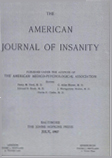DETOXICATION OF SODIUM BENZOATE IN NEUROPSYCHIATRIC DISORDERS
Abstract
The rate of detoxication of benzoic acid was determined in patients with various neuropsychiatric diseases. About one half of the patients with catatonia showed a defect in hippuric acid synthesis. This may be due to the state of muscular rigidity and immobility of these patients. Deteriorated patients with epilepsy showed a defect in the synthesis of hippuric acid, whereas extramural patients with epilepsy showed a normal excretion of the equivalent benzoic acid. This may indicate a defect in glycine synthesis in deteriorated patients with epilepsy. Normal average values were found in post-encephalitic Parkinsonism and multiple sclerosis. A patient with progressive muscular dystrophy was able to synthesize glycine at a normal rate.
Access content
To read the fulltext, please use one of the options below to sign in or purchase access.- Personal login
- Institutional Login
- Sign in via OpenAthens
- Register for access
-
Please login/register if you wish to pair your device and check access availability.
Not a subscriber?
PsychiatryOnline subscription options offer access to the DSM-5 library, books, journals, CME, and patient resources. This all-in-one virtual library provides psychiatrists and mental health professionals with key resources for diagnosis, treatment, research, and professional development.
Need more help? PsychiatryOnline Customer Service may be reached by emailing [email protected] or by calling 800-368-5777 (in the U.S.) or 703-907-7322 (outside the U.S.).



